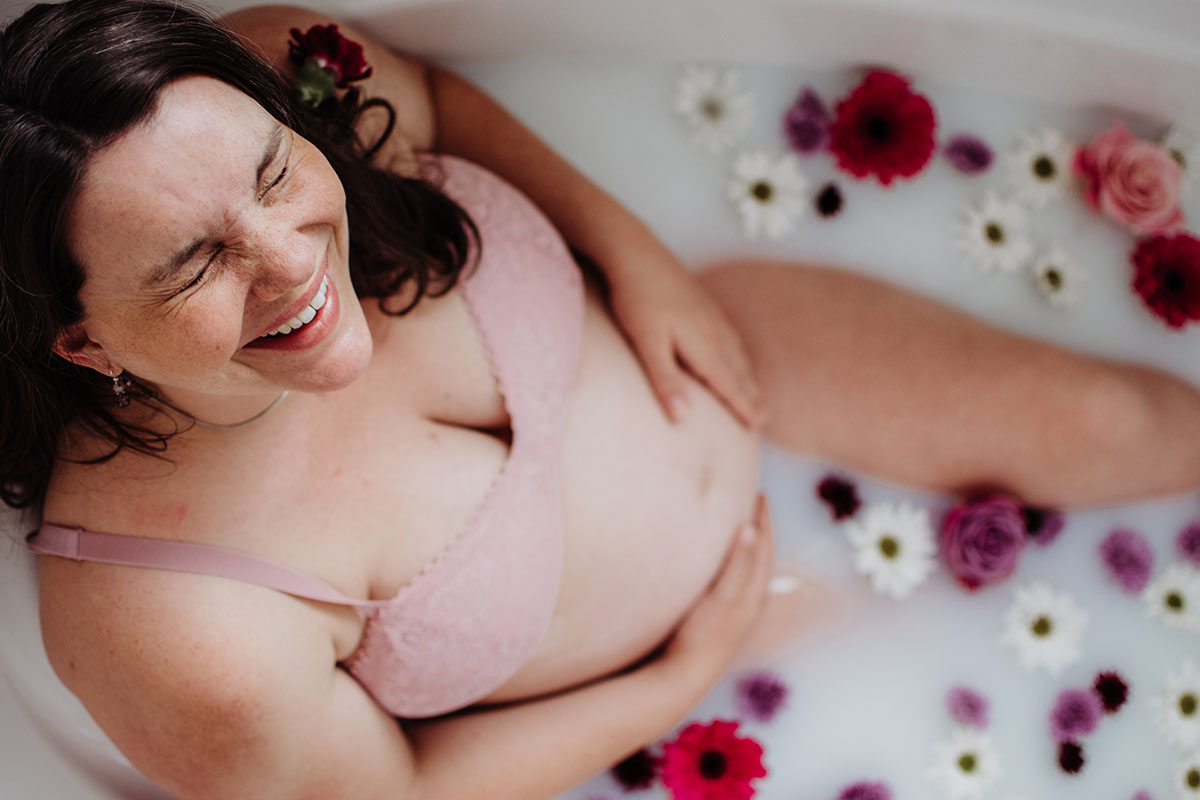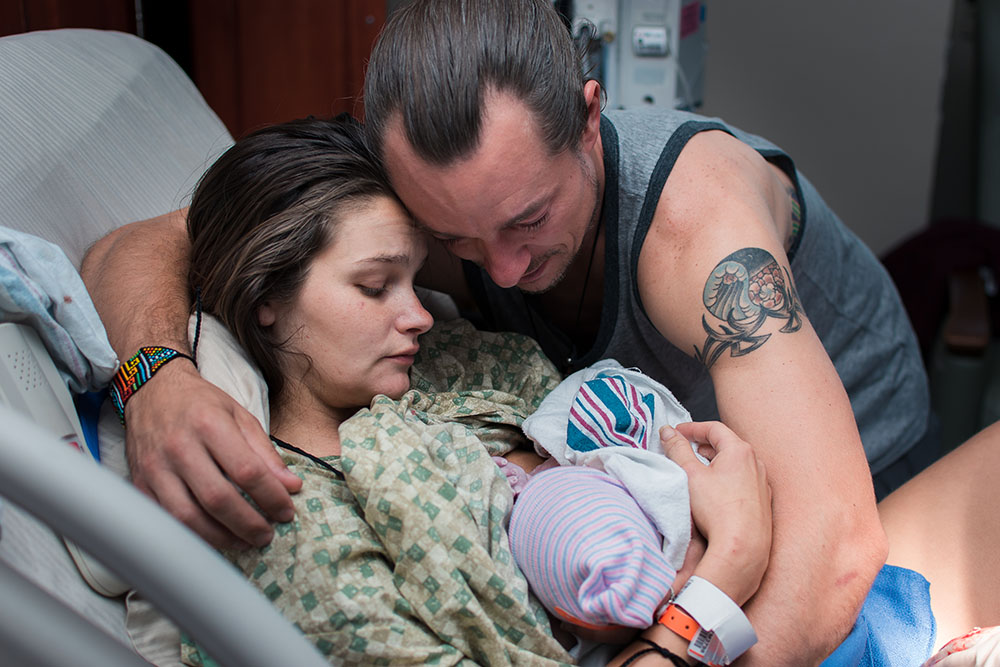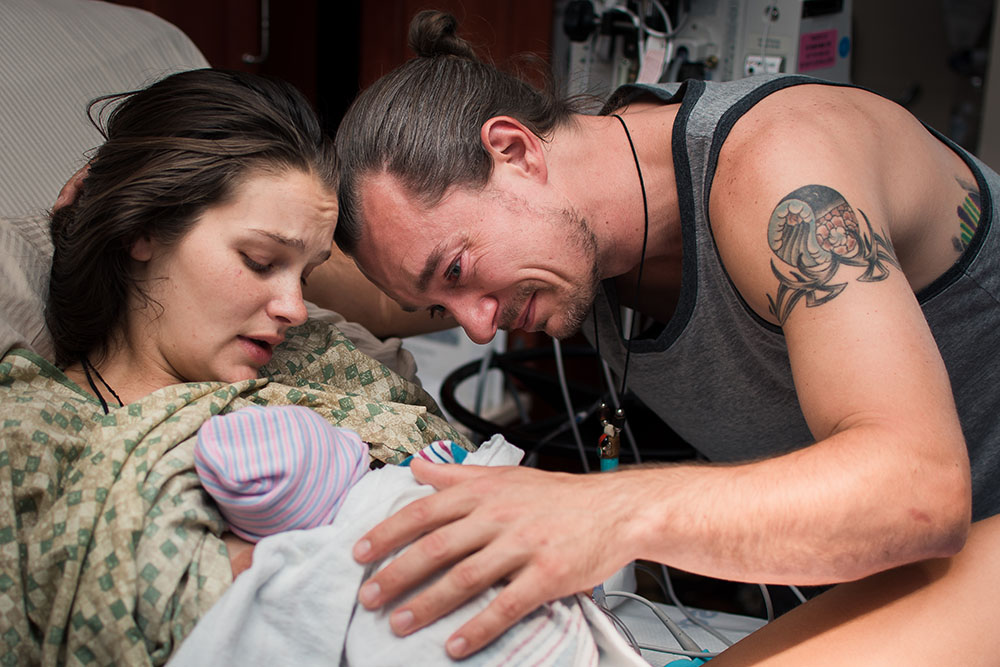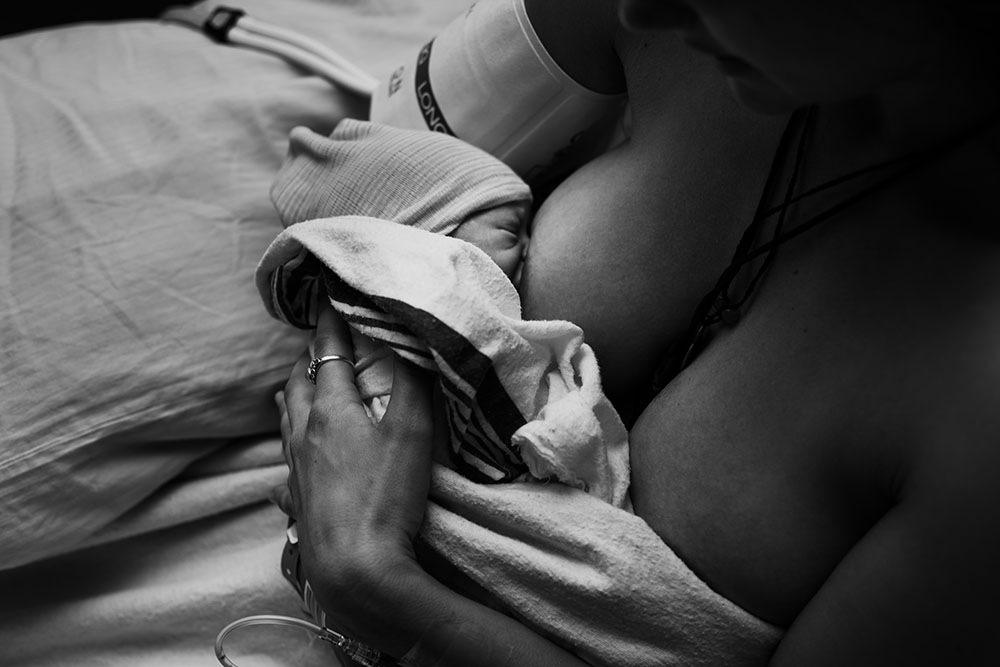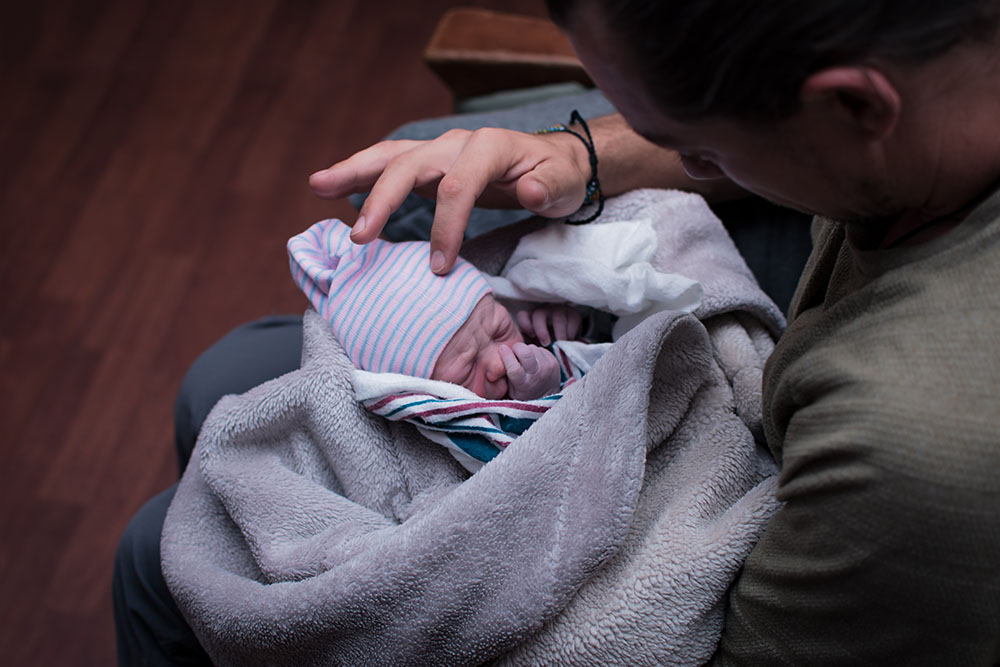Introducing Elowen Milo Rose
Some of you may remember the story of the stillbirth of Huckleberry Oliver that I shared via instagram and here on the blog for International Bereaved Parents Awareness Month. Huckleberry passed away in the womb at 38 weeks of life and left his family and friends here on Earth devastated and heartbroken.
A little over a year later, Elowen Milo Rose was born! She joined us Earthside at the end of May, and I wanted to share her newborn photos here for anyone following this family’s story. Her presence has been much anticipated and we are all so happy that she has arrived safely.
A Rainbow Baby Celebration
Some of you may remember the story of the stillbirth of Huckleberry Oliver that I shared via instagram and here on the blog for International Bereaved Parents Awareness Month. Huckleberry passed away in the womb at 38 weeks of life and left his family and friends here on Earth devastated and heartbroken.
A little over a year later, Elowen Milo Rose was born! She joined us Earthside at the end of May, and I wanted to share her newborn photos here for anyone following this family’s story. Her presence has been much anticipated and we are all so happy that she has arrived safely.
When Birth and Death Coincide
July is International Bereaved Parents Awareness Month. The purpose of this month is to promote support for bereaved parents. When a child dies, many times people don’t know what to do or say, so they do nothing. This movement, started by Peter and Deb Kulkkula, is meant to encourage people to reach out to bereaved parents; to listen to their stories without judgement for advice; to give them a shoulder to cry on and a hug when appropriate.
International Bereaved Parents Awareness Month is an opportunity to encourage healthy expressions of grief, sorrow, and pain in order to support the healing process. Most people feel uncomfortable approaching the topic of death, especially when it precedes or immediately follows birth, but talking about it is part of the healing process. This day is meant to encourage us to be more open to holding space for these conversations.
This post is dedicated to my dear friend and the spirit of her precious son.
Honoring International Bereaved Parents Awareness Month
July is International Bereaved Parents Awareness Month. The purpose of this month is to promote support for bereaved parents. When a child dies, many times people don’t know what to do or say, so they do nothing. This movement, started by Peter and Deb Kulkkula, is meant to encourage people to reach out to bereaved parents; to listen to their stories without judgement for advice; to give them a shoulder to cry on and a hug when appropriate.
International Bereaved Parents Awareness Month is an opportunity to encourage healthy expressions of grief, sorrow, and pain in order to support the healing process. Most people feel uncomfortable approaching the topic of death, especially when it precedes or immediately follows birth, but talking about it is part of the healing process. This day is meant to encourage us to be more open to holding space for these conversations.
This post is dedicated to my dear friend and the spirit of her precious son.
We met for her milk bath session on a Tuesday. The kids played together while I photographed her amongst the flowers. We talked and laughed as good friends do.
She told me about how she learned her son’s name recently during meditation. Huckleberry Oliver, to be called Huck. He would be her rainbow baby after a miscarriage the year prior.
The session went marvelously.
She is a classically beautiful woman. Her deep, soulful eyes are mesmerizing. Her smile and laugh are wonderfully contagious. Due to a background in theatre, music, and the arts, she wasn’t shy in front of the camera and she didn’t require much direction. We joked and laughed about awkward poses and didn’t once take ourselves too seriously.
When the session came to an end, we hung out for a little longer, discussing her upcoming birth. I went over the details of when she should call me. I told her I expected to hear from her frequently now that she was coming up on 38 weeks. We made plans to meet up again a week later just to hang out and let our children play.
Thursday afternoon, a text came in from her midwife asking to call me. I thought it was rather strange, but took the call before thinking too much into it.
In my memory, this conversation is now a blur, smudged over with overwhelming emotions. I know what words were said but I’m not sure how they were said or in what order. All I know is that just after 5 pm on this Thursday evening, the world seemed to stop spinning. This is the moment I learned that Huck’s heart was no longer beating. My stomach lurched and my heart felt ripped from my chest. I felt only a fraction of the pain, terror, and loss that my dear friend must have been experiencing, and it was unbearable.
Huckleberry Oliver was born on a Friday at ~ 2:30 A.M
As soon as he was born, it was obvious to the Obstetrician why his heart had stopped. His umbilical cord was wrapped tightly around his neck and shoulders, multiple times. His cord also had a true knot, meaning that somehow during gestation a knot formed in his umbilical cord (sometimes this happens as the baby flips and turns during pregnancy). Knots are actually quite common, occurring in about one in every 100 pregnancies; in one of every 2,000 pregnancies, a true knot causes serious problems.
When I walked into the hospital room, it seemed as though time was standing still. The lights were dim; the room was solemn. My dear friend was seated in the hospital bed, surrounded by a halo of lights from the wall behind her. In her arms was the most delicate angel I have ever laid my eyes upon. Huck rested in her arms peacefully, wrapped up in a pastel blue crocheted blanket.
Overwhelming love & grief filled the room.
The emotions were so palpable that the air felt thick; it was hard to breathe without a lump of sadness forming in my chest.
I stepped closer to my beloved friend and whispered, “May I touch you?”
Through silent tears, she nodded. I embraced her, and together we cried. Our minds retraced the events of the past few days. The shock. The unfairness. The tragedy.
I wanted to take all of her pain away. I wished I had the power to alter reality. I tried as hard as I could to pour every ounce of my love into our embrace.
Throughout the morning, the rest of the family trickled in and out of the room. They came in only one or two at a time, respectfully saying their goodbyes. Each of them studied him lovingly, commenting on his precious features that they recognized from their family lineage. His grandmothers took a few moments to rock him in the rocking chair.
It seemed as though his spirit lingered for long enough to take in the love that was pouring from all of us. At least that is what I’d like to believe. Huckleberry Oliver was so very loved. So very wanted. So very appreciated and anticipated. I seek solace in the knowledge that this Love was all he ever knew.
Update: This family has now welcomed a rainbow baby girl, Elowen Milo Rose.
When someone loses a baby (or child), it can be hard to know exactly what to do. I thought I’d list a few tips here to get you started in case you ever find yourself in a position where you need to lend support to someone who has experienced loss.
What not to do:
Make the situation about yourself. Don’t talk about the baby (or child) you lost or that a friend has lost to the parents unless they specifically ask about your experience. This isn’t what they need to hear right now.
Tell them everything happens for a reason. This will not console anyone who has just lost someone dear to them, especially when life is lost so young.
Tell them they can always have more babies. This baby is theirs and always will be a part of their family. No baby will ever replace this baby.
Don’t ask how you can help, just offer specific help. It is too difficult them to think of practicalities through their grief.
What to do:
Listen when they talk about their child. This may bring sadness but the memories are all they have and so they are beautiful.
Offer some things they will absolutely need: housekeeping (laundry and dishes especially), childcare for siblings so mom and dad can get time with each other to grieve, food on rotation, and possibly donations so they can afford memorial services and mental health support. They will need to feel support from their community for a long time, so don’t forget about them after two weeks or even four weeks of care. Even if you can drop by just once a week for two months to bring food or do a load of laundry, that would be wonderful.
Reach out. Don’t force yourself on the family, but DO send an email, text, or written card to them saying they are in your thoughts. It means more than you’d know.
If you can, send a gift card to a local food delivery place, a local grocery store, or even a maid service.
Sending all my love to anyone and everyone who is honoring a lost life today (and everyday),
Why Americans Should Be Spending Less On Weddings And More On Maternal Care
I find it strange how much we as a culture focus on weddings. People spend so much money on having a big party… for what? To announce their love for one another? Usually they’re already living together, in this day and age, with the ridiculous cost of rent. Weddings are such an outdated tradition, yet the industry is raking in tens of billions of dollars each year. The average cost of a wedding in the U.S. is $33,391.
I never had a wedding. I couldn’t rationalize spending so much money on one day of my life when we knew what we really wanted was to have children together and own our own home. I decided I would rather invest that money in our future than throw a big party.
In my personal opinion, parenthood is a much bigger step. It is mentally, physically, and emotionally challenging. Crossing the threshold into parenthood is a rite of passage; it shouldn’t be an afterthought. A couple should absolutely plan to allot plenty of resources to care for themselves through this transition. Just think of the comfort that could be afforded with less than half of what the average wedding costs!
I find it strange how much we as a culture focus on weddings. People spend so much money on having a big party… for what? To announce their love for one another? Usually they’re already living together, in this day and age, with the ridiculous cost of rent. Weddings are such an outdated tradition, yet the industry is raking in tens of billions of dollars each year. The average cost of a wedding in the U.S. is $33,391.
I never had a wedding. I couldn’t rationalize spending so much money on one day of my life when we knew what we really wanted was to have children together and own our own home. I decided I would rather invest that money in our future than throw a big party.
In my personal opinion, parenthood is a much bigger step. It is mentally, physically, and emotionally challenging. Crossing the threshold into parenthood is a rite of passage; it shouldn’t be an afterthought. A couple should absolutely plan to allot plenty of resources to care for themselves through this transition. Just think of the comfort that could be afforded with less than half of what the average wedding costs!
A Listening To Mothers Survey data brief reports that in the first two months after childbirth 51% of women reported physical exhaustion, 58% reported sleep loss, and 43% reported not getting enough exercise. About 1/3 of the women surveyed reported that their postpartum physical and emotional health interfered at least some with their ability to care for their new baby. Many women reported that they were not getting enough healthy foods and they were unable to handle stress well. The reported rate of clinical postpartum depression among new mothers is between 10% to 20%, and we are now finding that postpartum anxiety may be even more common than postpartum depression. Anxiety and related disorders were found to affect more than 15% of pregnant and postpartum women, and suicide is one of the leading causes of death in postpartum women.
Photo © Rose Motherhood
With these statistics in mind, it is shocking to me that our culture spends so much on extravagant weddings yet is willing to spend so LITTLE on maternal care. It got me thinking… do people even know all of the resources available to them throughout the childbearing year? I think not! I think for too long we have assumed that having a baby just sort of happens. We didn’t consider the mental and physical ramifications of being unprepared and unsupported. We knew that we needed items and services to care for the baby after they arrived, but we forgot to consider the mother (and father, for that matter).
I would like to reframe everyone’s expectations around prenatal and postpartum care. We need to expect and budget for AMPLE care throughout the childbearing year whenever possible. We need to consider it an investment in our mental and physical health instead of an “extra expense.” It is not extra, it is NECESSARY. It can make all the difference!
One of the first ways we can influence this cultural shift is to educate everyone about the various options they have when it comes to taking care of themselves throughout this time.
Prenatal Care
Pregnancy is intense! You need to care for your mental and physical health throughout pregnancy. It is important to be able to afford wholesome, nutritious foods and high quality prenatal vitamins. Not only is it important to have a good care provider, you can also benefit greatly from holistic care such as regular chiropractic, massage, and acupuncture appointments.
Your Choice of Care Provider
Whether you want to birth with an obstetrician or a midwife, you would have the ability to choose freely regardless of cost. I have had quite a few clients who felt forced into a certain birth plan simply because it was all their insurance would cover. You don’t want to feel stuck with a care provider who isn’t serving you well.
Your Choice Of Birth Location
A recent USA Today investigation showed that about one in eight hospitals have complication rates of at least double the norm. When your life and your child’s life is at stake, you want to have the ability to choose the safest place to birth. The United States is the most dangerous place to birth in the developed world. About 700 women die and more than 50,000 suffer serious complications each year. For many years, hospitals have blamed the rising maternal deaths on poverty and pre-existing conditions, but USA Today’s investigations suggest that the deaths can be blamed on a mix of misdiagnoses, delayed care and a failure to follow safety measures. USA Today released a database of childbirth complication rates at maternity hospitals that families can access when they are making a choice about where to birth. You don’t want to feel pressured into birthing in a certain location that may not be your safest choice.
Photo © Rose Motherhood
Birth Doula
A Birth Doula is like your Birth Fairy Godmother. They are hired as early on in the pregnancy as possible so they are able to support you every step of the way. Your doula is like your very own encyclopedia for all things birth and babies. They are equipped with a great deal of knowledge about your local birth & parenting community, so they can act as your “birth/parenthood” planner of sorts, referring you to the people and care providers who will serve you best. Most of them are available to you for advice throughout pregnancy, labor (obviously), and postpartum. No matter what question you have, they will have the answer or find someone who does. That is invaluable! Wondering why your baby’s poop just turned green? Text the doula! Wondering if this is the start of labor? Text the doula! Wondering which birth or parenting books you should bother reading? Text the doula! She probably has a lending library as well. Your doula is like your parenting side-kick. We want you to feel at peace throughout this transition and we will go above and beyond to ensure that we make the transition as smoothly as possible. Not only does your doula act as the “wedding planner” of the maternal care world, we also STAY WITH YOU throughout your entire labor & birth to keep you as comfortable and calm as possible throughout the experience. Doula care has been linked to less complications during birth, less interventions, a lower chance of cesarean section for first time mothers, a higher likelihood of establishing a good breastfeeding relationship, and a higher likelihood that the parents will rate their childbirth experience positively.
Childbirth Prep Classes
If this is going to be your first baby, you might want to invest in some childbirth prep classes. You can take classes focused on birth, newborn care, breastfeeding, or a mix of everything. They vary greatly in price, and can last anywhere from a few hours to several weeks of recurring meet-ups. Some instructors teach their own curriculum, while others have been trained in childbirth education by organizations like Evidence Based Birth or Birthing From Within (a couple of my personal favorites). It is a good idea to take an in-depth course before jumping into parenthood head first. You’d be surprised at all the things you don’t know!
Chiropractic Care
Chiropractic care throughout pregnancy is important for treating sciatic pain and pubic symphysis pain, and for creating space in your pelvis for your baby to settle into the most optimal position for birthing. Good chiropractic care throughout pregnancy can reduce the length of labor and reduce your risk of cesarean delivery. There are even techniques a chiropractor can use to encourage breech babies to turn! Chiropractic care is the most beneficial when part of a regular care regimen.
Massage
Massage has a wide range of benefits— relaxation, improved circulation, better sleep, reduced swelling, less aches/pains/tension, reduced stress, better labor outcomes, and more! Toward the end of pregnancy, many massage therapists (such as myself) offer “induction” massages, designed to gently nudge your body into labor to avoid unnecessary medical intervention. I highly recommend having regular massage appointments scheduled throughout your third trimester, but having them throughout your entire pregnancy is even better!
Acupuncture/Acupressure
Benefits of Acupuncture/Acupressure during pregnancy include: Relief of morning sickness & nausea; increased energy levels; treatment of migraines; reduction of aches & pains; easing or diminishing symptoms of depression & anxiety; encouraging labor, augmenting labor naturally, & reducing length of labor; improved sleep, and more. I usually recommend my clients begin acupuncture treatments in the third trimester to reduce their anxiety and stress levels, then increase the frequency after the 38th week of pregnancy, when the practitioner can begin using the points to encourage labor to begin. This significantly reduces the chances of going past 42 weeks, which means less unwanted interventions. Acupuncture/acupressure are accumulative, meaning it takes more than one treatment to trigger a response in your body. This is why it is recommended you have regular appointments leading up to your due date, instead of going once at 41.5 weeks in hopes it will bring your baby.
Photo © Rose Motherhood
Photographer
This may not be an absolute necessity, but birth photography is definitely a service that could be factored into the budget. After all, we spend a heck of a lot of money hiring wedding photographers, don’t we? I’d say that having a baby is a WAY BIGGER DEAL than your wedding day. Don’t you want to remember every detail from such a powerful, life-changing event? I know I cherish the photos that were taken during each of my births! Even if you decide you don’t want a photographer present for the actual birth, MANY birth photographers (including myself) offer a “Fresh 48” option. For a Fresh 48 session, a photographer is still technically on-call, but they agree to show up within 48 hours of your baby’s birth. That means they’ll capture all the fresh details of your newborn: tiny fingers, wrinkled feet, and precious baby hairs. During labor, birth, and the early postpartum, your body naturally produces hormones which cause you to forget the experience. This is why having visual documentation of this day is so priceless. Without these photos you will only have a fraction of this experience logged in your memory, but with them you will have an everlasting reminder of this wondrous time, down to every important detail.
Postpartum Care
Oh, you thought pregnancy was intense? The postpartum period kicks it up a notch! Many women describe their first postpartum experience as feeling like they have been hit by a freight train. You are feeling exhausted, vulnerable, and somewhat overwhelmed with the task of caring for new life. You are required to learn a long list of new skills overnight: how to feed your baby, how to burp your baby, how to coax your baby to sleep, and more! That’s not including the care you need yourself. Perineal care, cesarean incision care, pelvic floor care, a healthy diet to maintain milk supply and energy levels, etc. The list goes on and on. The services listed below are necessary for easing the postpartum load. Trust me, it’s a doozy. Especially since only 25 percent of fathers have more than a week of paternity leave and a majority take only a single day off work after their partner has a baby. What is a mother to do when her partner returns to work and she is left caring for herself and their new baby? HIRE HELP, whenever possible!
Postpartum Doula
Remember that long list of new skills I mentioned you’ll need to learn overnight? Your postpartum doula can help you with ALL OF THEM. Postpartum doulas are highly skilled in caring for all your postpartum needs, as well as your newborn’s needs. We provide emotional support, evidence-based information regarding caring for your newborn, and practical support like helping with the laundry or preparing/bringing a nourishing meal. Postpartum doulas help reduce postpartum mood disorders and improve breastfeeding success rates. Some postpartum doulas offer overnight services so that you AND your partner are able to get some much-needed rest!
Photo © Rose Motherhood
Lactation Consultants
Lactation consultants provide advice and hands-on help for anything about breastfeeding. In the beginning, they can help you with positioning baby, solving latch problems, or handling night feedings. Even after you have established breastfeeding, a lactation consultant can help with things like too much milk, too little milk, making the transition to work, or learning to pump. An International Board Certified Lactation Consultant® (IBCLC®) is a healthcare professional who specializes in the clinical management of breastfeeding. IBCLCs have a unique body of knowledge and skill to provide breastfeeding and lactation care in routine and high-risk situations. Most of the time, a doula can assist with the most basic breastfeeding issues, but if a problem persists or a lip/tongue-tie is suspected, usually your doula would refer you to an IBCLC.
Therapist/Counselor
Birth and motherhood are challenging. Sometimes, unfortunately, birth experiences can be traumatic. There are therapists who offer special birth trauma counseling to help women heal from PTSD following childbirth. Sometimes, even if you had a wonderful birth experience, depression and anxiety creep in during the postpartum period. If you have had depression or anxiety symptoms at other times in your life, this is even more likely. Plan on reaching out for help if you need it. Don’t suffer silently! Studies have shown that 1 in 5 postpartum deaths are suicide related. Don’t wait til it is overwhelming to talk about it. This is why it is important to have people checking in on you postpartum- people who know the signs of postpartum mood disorders, who can refer you to a counselor if you need one.
Pelvic Floor Therapy
Photo © Rose Motherhood
There are many birth workers who agree that seeing a pelvic floor therapist after giving birth should be the norm. Many women have pelvic floor issues after childbirth! A weak pelvic floor can cause pelvic pain, pain with sex, leakage (fecal and urinary), back pain, rectal pain, and even organ prolapse. Even something as simple (and common) as bladder leakage after birth is not normal! Seeing a pelvic floor therapist can restore your pelvic floor before the problems get worse.
Other Self-Care
There are many other expenses to consider when it comes to taking care of yourself postpartum, mentally and physically. Self care can include gym memberships (with childcare), hiring babysitters so you and your partner have time to yourselves, hiring a maid to reduce your work load at home, and even things like ordering food or grocery delivery. I know MANY parents who take advantage of at least one of these services postpartum (usually food delivery… because let’s be real, grocery shopping and cooking can be overwhelming with a new baby to care for).
____________________
Maternal care shouldn’t be an afterthought. Just as we plan for the baby’s needs, we should plan extensively for the mother’s needs during the childbearing year. If we can find the money for a wedding, why can’t we allocate those funds (or at least a portion of them) to our health?! The answer to maternal health does not lie in $34,000 drug infusions. We need to be providing high-quality holistic care to mothers throughout pregnancy, birth, and postpartum. Maternal care is not a luxury– it is a necessity. It is an investment in the health and future of our society as a whole.
Ecstatic Birth in Austin, Texas
The story of a woman who turned her unexpected hospital birth into an ecstatic birth.
Do you believe in fate?
I do. I absolutely believe with all my heart and soul that SOME moments are just destined to happen. “Fate” is how I ended up at the hospital, supporting a woman who I’d originally met at a city-wide clothing swap through the labor and birth of her second child.
I remember the evening we met. We both happened to attend a clothing swap event at Soma Vida. Each of us had our eldest sons (our only children at that time) in tow. She approached me out of the blue. Just tapped me on the shoulder and introduced herself. The clothing swap was a bit hectic, so it was hard to focus on our conversation, but I was impressed with how straight forward and friendly she was right from the start. I felt an underlying connection, but couldn’t explain why. Over the next few years we ran into each other at random events around town.. Each time we would greet one another like old friends, but we didn’t talk much in between.
Fast forward to recent events:
The story of a woman who turned her unexpected hospital birth into an ecstatic birth.
Do you believe in fate?
I do. I absolutely believe with all my heart and soul that SOME moments are just destined to happen. “Fate” is how I ended up at the hospital, supporting a woman who I’d originally met at a city-wide clothing swap through the labor and birth of her second child.
I remember the evening we met. We both happened to attend a clothing swap event at Soma Vida. Each of us had our eldest sons (our only children at that time) in tow. She approached me out of the blue. Just tapped me on the shoulder and introduced herself. The clothing swap was a bit hectic, so it was hard to focus on our conversation, but I was impressed with how straight forward and friendly she was right from the start. I felt an underlying connection, but couldn’t explain why. Over the next few years we ran into each other at random events around town.. Each time we would greet one another like old friends, but we didn’t talk much in between.
Fast forward to recent events:
I take part in conversations on many local and worldwide Facebook groups that have to do with pregnancy, birth, and mom life. One day, I saw a post by her about her pregnancy in a group we both happened to be in. I had never seen her before in this group, and I hadn’t even realized she was pregnant (it had been months since I’d seen her in person). Immediately, I reached out to her to reconnect and offer my support.
Our original spark instantly ignited once again, and we ended up talking on the phone over the next few days. During this time, she discovered there were complications with her pregnancy. Instead of the calm and peaceful birth center birth she had planned, she would need to be induced in the hospital for the safety of her baby. Due to the change of environment and the uncertainty of the situation, she requested my presence as her Doula and I didn’t have to think twice before agreeing.
My intuition told me that although this was last minute and unplanned, everything would work out and this was where I needed to be.
Only a little over 24 hours later, I found myself walking into the hospital to support her. Everything was going well but her body wasn’t progressing as quickly as it had with her first. I could see that she was still having trouble adjusting to all of the changes in her plans. She wanted to be accepting of everything but naturally she had some mental blocks. I massaged her feet, did some acupressure, and we talked through these mental blocks. Her feelings were valid and she needed to allow them to flow freely instead of suppressing them.
“It’s okay to feel frustrated, anxious, and/or upset,” I said. “It’s okay to acknowledge these emotions. It will help you move forward.”
Kristine is a remarkable woman. Her mind is so powerful, and she had worked hard to convince herself that she was okay with this new twist in the story. For the most part, she was okay with it— but she still needed to allow herself time to adjust.
Another thing we worked through was her deep fear of cesarean. It was always on her mind. I guided her through the process of surrendering to the experience. It was unlikely she would need a cesarean, but thinking about it constantly (even thinking “I don’t want a cesarean”) was obsessive and would have negative effects on how her labor progressed. We moved past this mental barrier as well.
After these long heart to heart conversations, her labor started to pick up. She laughed and danced with her partner, talked to her son via FaceTime, drank copious amounts of coconut water, and birthed like a boss.
Eventually, she grew tired, and so did her uterus. It was so late in the night that it was actually early in the morning the next day. She and her doctor made the decision to turn off the pitocin so she could get some sleep and continue later in the morning. I tucked her in, kissed her on the forehead, and went home to nurse my own baby while taking a short nap.
The next morning, after they resumed the induction, Kristine and Charles spent a few hours before noon laboring together as a couple. Their love for one another is so powerful and magical— the perfect spark to get the oxytocin flowin’ in order to fuel a strong, efficient labor. Charles called me back to the hospital when things were going steadily. Kristine was prowling around the floor like a mother lioness. She transitioned between squatting, hands-and-knees position, and crouching on the floor while holding onto Charles’ hands as he pulled upward to give her traction.
I wished we were in a birthing hut with a rope hanging from the ceiling. It was obvious that Kristine would’ve benefitted from that ancient birthing practice. She was now in what some of us birth workers call “Labor Land.” None of us were talking much. The extraordinary thing about Kristine was that she didn’t complain at all. She knew instinctively that she wanted her contractions to be strong. If she made noise at all, it was low, satisfied hums. Her body was able to work quickly and efficiently because she wasn’t fighting it.
It wasn’t long before she was ready to push.
She decided she wanted to squat in the bed. With every contraction, her face would scrunch as she pushed with her body’s cues. Then she would relax into an ecstatic state of rest in between, smiling from ear to ear with her eyes closed. She allowed her body to guide her; to tell her when to push and when to rest. No one in the room coached her or directed her. Everyone watched in awe as she birthed her baby.
The amniotic sac was the first thing to show. It was bulging, but everyone remained hands-off, hoping to see a baby born en-caul. As soon as his head burst through the birth canal, her “bag of waters” broke and amniotic fluid sprayed directly into her midwife’s face. Her son’s body followed very quickly, and soon she was holding him in her arms.
I always love the look on a woman’s face immediately after she delivers her baby, but Kristine’s was especially brilliant. She looked deliriously happy as she thanked everyone in the room over and over again.
“This experience taught me so much,” she told us, through tears. “I love you all! Thank you thank you!”
I cannot tell you how honored I am to be a part of experiences like this. I love being able to assist women through such a monumental transition in their lives. Every birth brings us unexpected hurdles, and being able to guide other women through this process, supporting them physically, emotionally, and even spiritually… well, it’s priceless.
Postpartum Herbal Bath Recipe
Learn how to prepare a postpartum herbal bath with dried herbs and flowers.
This DIY herbal bath will aid in postpartum recovery. You can enjoy this herbal bath mix in the tub or in a sitz bath.
Warm herbal baths are a wonderful way to relax and encourage healing postpartum. After all three of my births, I have used postpartum herbal baths to heal quicker. I always look forward to them! They smell absolutely delicious and it’s the perfect way to pamper yourself postpartum.
The herbs used in my postpartum herbal bath recipe have the power to decrease inflammation, heal tears and episiotomies, soothe the tender tissues in your perineal region, and diminish hemorrhoids. After a vaginal birth, it is perfectly safe to begin taking baths (or sitz baths) as long as you are healthy and show no signs of infection. I should note that regular baths are not safe for mothers who have had a cesarean birth, but sitz baths should be fine (consult your care provider).
This post contains affiliate links. I only link to products that I have personally used and feel comfortable recommending. If you use these links, it does not increase the cost for you. It does help support this blog and my family, which allows me to bring you more helpful content. I really appreciate it when you use these links to purchase these products!
Learn how to prepare a postpartum herbal bath with dried herbs and flowers.
This DIY herbal bath will aid in postpartum recovery. You can enjoy this herbal bath mix in the tub or in a sitz bath.
Warm herbal baths are a wonderful way to relax and encourage healing postpartum. After all three of my births, I have used postpartum herbal baths to heal quicker. I always look forward to them! They smell absolutely delicious and it’s the perfect way to pamper yourself postpartum.
The herbs used in my postpartum herbal bath recipe have the power to decrease inflammation, heal tears and episiotomies, soothe the tender tissues in your perineal region, and diminish hemorrhoids. After a vaginal birth, it is perfectly safe to begin taking baths (or sitz baths) as long as you are healthy and show no signs of infection. I should note that regular baths are not safe for mothers who have had a cesarean birth, but sitz baths should be fine (consult your care provider).
I recommend either a sitz bath or a shallow herbal soak for at least 10 minutes once per day for the first week or so after giving birth. I found it easier to do a sitz bath most days for 10 minutes, with a longer 20-30 minute bath in the tub every 3rd day or so. Sitz baths are also a great option if you don’t have a tub or you just don’t feel like immersing your entire body. A sitz bath is a small basin that rests on your toilet; they are inexpensive and you can purchase a good one through amazon by clicking this link. It isn’t anything fancy… all you need is the basin that fits into your toilet; don’t worry about any extra gadgets that come with it, you won’t need those.
Your baby is also welcome to accompany you into the bath! This herbal bath recipe is great for healing their umbilical stump (just be sure to dry it completely if it gets wet). A word of warning: you don’t want to end up with baby poo in your luxurious postpartum herbal bath, so time feedings and bath accordingly! Trust me, I’m speaking from experience.
If you don’t feel like purchasing bulk herbs and making this sitz bath recipe for yourself, you can totally just buy them pre-made — I recommend THIS ONE by Birds & Bees Teas Company. Their prepared postpartum herbal bath sachets are great quality, and I know from experience that they WORK to help heal after birth. I love Birds & Bees products, so when I am too busy or short on time to make this recipe myself, I always purchase from their brand on Amazon. If you go forward making this recipe, you get FAR more bang for your buck. You can afford to take an herbal bath daily, or even gift/sell to friends if you have extra.
For the sitz bath, prepare a medium pot of water (about 2 quarts) with 1 cup of the mixed herbs. Boil the herbs in the water, then stir and simmer for 15-20 minutes. Turn off the heat, let it cool for a few minutes, then strain out the herbs and pour the concentrated herbal bath water into a pitcher with a lid. Then over the next couple of days simply mix this infusion with hot water (50/50 split) into your sitz bath basin. It will stay good for 2-3 days in the pitcher.
For a tub bath, prepare a medium pot of water (about 2 quarts) with 1 cups of the mixed herbs. Again, bring the herbs to a boil, then simmer for another 15-20 minutes. Let it cool for a few minutes, then strain into a large bowl. Pour directly into a shallow bath. Let your perineum soak for 10 minutes, then add more water and relax for another 10-20 minutes (or however long you want)!
You can also use this infusion in your peri-bottle for extra healing powers each time you use the bathroom! I like to do 75% herbal infusion + 25% witch hazel for extra anti-inflammatory benefits. (PS. THIS is seriously the best peri-bottle for postpartum healing because it is easy to hold while spraying your perineum. It’s a totally genius design that everyone raves about.)
DIY Postpartum Herbal Bath Recipe:
This recipe yields 6 cups of postpartum herbal bath mix, which is enough for a week of postpartum herbal baths if you alternate sitz baths & tub baths.
1/2 cup Chamomile Flower
1/2 cup Calendula Flower
1/3 cup Comfrey Leaf
1/3 cup Lavender Flowers
1/3 cup Yarrow Flower
1/3 cup Shepherd’s Purse
1/3 cup Uva Ursi Leaf
1/3 cup Sea Salt -or- Epsom Salt
Chamomile is antibacterial, anti-fungal, anti-inflammatory, and antiseptic. It is well known for improving skin conditions and calming irritated skin.
Calendula is a gentle and soothing herb for the skin. It is antimicrobial, antiseptic, and promotes cell repair, which makes it perfect for speeding up the recovery of wounds.
Comfrey relieves pain and inflammation, and helps speed up the recovery of wounds. It is said that comfrey can inhibit bleeding and even facilitate bone regrowth/healing! Not to be taken internally as it is bad for the liver in high doses.
Lavender has a lovely scent that has a soothing & calming effect. It is said to reduce depression, restlessness, and insomnia. It also contains anti-inflammatory and antiseptic properties which will aid in the perineal healing process.
Yarrow is anti-inflammatory and antibacterial. It can help stop bleeding when applied to wounds, and it helps relieve hemorrhoids.
Shepherd’s Purse is best known for its ability to inhibit or reduce bleeding. A tincture is sometimes used after childbirth to contract the uterus and prevent hemorrhage. Its astringent properties make it beneficial when applied externally to a wound as well.
Uva Ursi is antiseptic, antibacterial, anti-microbial, and anti-inflammatory. It contains allantoin which is well known for its soothing and tissue-repairing properties.
Sea Salt / Epsom Salt baths lower the risk of infections. The salts are anti-inflammatory and mineral-rich, which can aid in the healing process as well.













